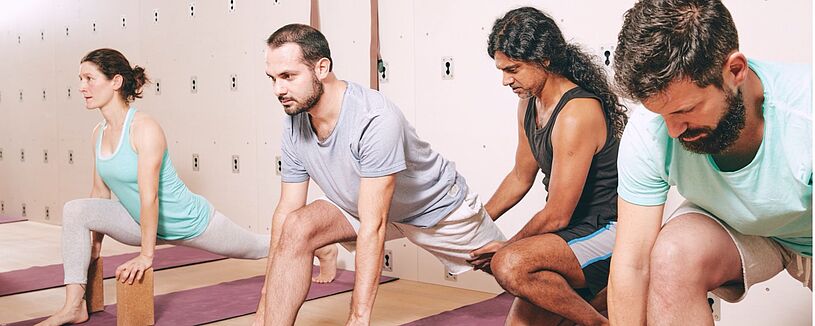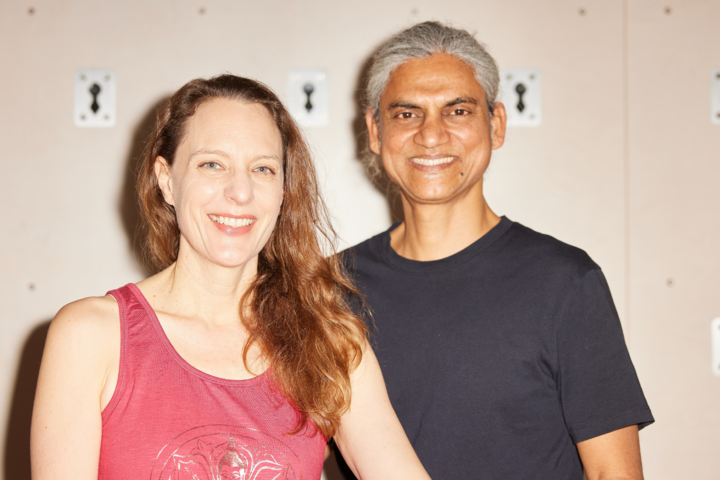Why Yoga is not just good for your back
Is yoga the right choice for back pain?
Back pain is no fun for anyone. Regardless of whether it's in the lower or upper back. Back pain slows us down in our enjoyment of life and also leads to many absences from work.
A representative survey conducted by the Rheumaliga in 2022 revealed that 8 out of 10 people suffer from back pain at least once in their lives. And 50% of all respondents said that they suffer from back pain several times a week or several times a month. That's huge!
So if you are a yoga teacher, like me (Tanja) and Joey here in Zurich, there is a very good chance that someone with back pain is in your yoga class. Yoga is actually good for many people with back pain, but unfortunately not everyone!
In this article, I would like to explain why this is the case and what you need to look out for if you are teaching yoga and there is someone in your yoga class who has back pain, by looking at the 3 main mistakes that lead to even more back pain in yoga.
Summary - why yoga isn't just good for your back
- Back pain is a common problem that can affect quality of life.
- 80% of people experience back pain at least once in their lives, 50% several times a week or month.
- Yoga can help with back pain, but it is not suitable for everyone.
- Three main mistakes when teaching yoga to people with back pain:
1. inappropriate yoga style: not every style is suitable for back pain, e.g. flow or vinyasa yoga can make the pain worse.
2. lack of anatomy knowledge: A solid understanding of anatomy is important to make yoga exercises safe and effective.
3. inappropriate forward bends: deep bending should be avoided for acute back pain.
- Yoga can be an effective method of relieving back pain if practiced correctly.
- Recommendation for yoga teachers: Alignment yoga teacher trainings to improve alignment and anatomy knowledge.
3 main mistakes you should avoid as a yoga teacher when someone has back pain
Mistake 1 with back pain and yoga: yoga style unsuitable
Not every yoga style is equally suitable for back pain. If someone has back pain and attends a flow yoga class or vinyasa yoga class, it often happens that the back pain is worse afterwards.
Many participants even stop doing yoga because they think yoga is not for them. That doesn't have to be the case! What is important when you have people with back pain in your yoga class is that you can explain to them exactly how to align themselves correctly in the yoga postures (asana) and that the participants have enough time to assume the postures slowly and mindfully and that they can stay in the posture for a moment so that the exercises can take effect.
As a yoga teacher, you should also know how to verbally guide the participants correctly and how to correct them safely in the pose without hurting them or aggravating their back pain.
It is understandable that such an approach is not compatible with a pure flow yoga style, such as vinyasa yoga, where the yoga exercises are usually demonstrated in front of the participants, the change of exercise takes place relatively quickly and there is often no time for individual corrections to the participants.
If you would like to do things differently in the future, take a look at our Alignment Yoga Teacher Training courses. We have 3 modules, from the basic training to the expert training.
Mistake 2 with back pain and yoga: too little knowledge of anatomy
Yoga teachers often lack a good foundation in anatomy. Of course, yoga teachers are not physiotherapists, but that does not excuse us from a lack of knowledge of anatomy.
Yoga exercises are performed with the body and some of the postures are quite complex, so you need to know how the joints should be positioned correctly and which postures tend to aggravate or alleviate back pain.
For example, offering someone a twist pose for back pain can really backfire. Depending on the pose, twisting poses are good for the back and mobilize the spine, but if they are unstable and performed incorrectly, they can have the opposite effect, especially if someone has acute back pain. So you actually need to briefly check every yoga pose against your anatomy.
Let's stay with the example of the twisting pose: as a yoga teacher, I need to understand how the spine is structured. I don't need to know every bone, muscle or ligament by heart, but I do need to have a basic understanding of the mechanisms of the spine: for example, the cervical spine is much more flexible than the thoracic or lumbar spine, and this understanding helps me to instruct and correct the twisting pose so that I don't injure anyone during my yoga class or when deciding that person X shouldn't do a twisting pose today.
If I know how to position the pelvis correctly in twisting poses, I can prevent damage to the lower back and lumbar region. Of course, you don't learn all of this in a single day, but if you get a good and practical anatomy foundation in your yoga teacher training from the start, as we do in our alignment yoga teacher training courses, you can teach more competently later on.
Mistake 3 for back pain and yoga: bending forward
A simple basic rule for acute back pain in yoga: NO deep FORWARD BENCHES! They may be good for pure stiffness and tension in the back, but if you have back pain, you should stay away from them for the time being.
In our advanced yoga teacher trainings (the 300h and 250h Alignment Yoga Teacher Trainings) we go deeper into this point and learn where the focus should be for people with back pain and at what point you can introduce which forward bends.
In conclusion, I would like to say once again that yoga can be a wonderful method for combating back pain and is therefore a good choice if the yoga style is appropriate and the yoga teacher knows which yoga exercises make sense and which do not and keeps an eye on correct alignment.
In our yoga studio in Zurich (The Yoga Place), there are many participants who originally started yoga because of back pain and were able to alleviate these problems through our Alignment Yoga method.
Find out more about Alignment Yoga here: WHAT IS ALIGNMENT YOGA
Find out more about our ALIGNMENT YOGA TEACHER TRAINING here
Comparison table yoga styles pros and cons back pain
| Yoga-Stil | Vorteile bei Rückenschmerzen | Nachteile bei Rückenschmerzen |
|---|---|---|
| Hatha Yoga | Rather gentle movements, suitable for beginners. | Often no props to support correct alignment |
| Slowly taking the pose, breath is integrated. | Anatomy or correct alignment are often missing in yoga teacher training courses for those who teach the classes. | |
| Vinyasa Yoga | Quick changes of exercises are not suitable for back pain. | Fast movements can aggravate pain |
| Can increase flexibility and muscle strength if it is only tension. | No time for individual adjustments and correct alignment in yoga classes. | |
| Iyengar Yoga | Focus on precise alignment and attention to detail. | Yoga Exercises can sometimes be too complex - pay attention to the level of the class. |
| Use props for correct posture and support. | Anatomy is not sufficiently covered in teacher training. | |
| Kundalini Yoga | Combines spiritual and physical aspects, can help with the mindset. | Some postures can be too intense for back pain and also changing postures too quickly. |
| Breathing techniques and meditation can help with back pain. | Little focus on anatomy or correct alignment in the classes. | |
| Yin Yoga | Passive stretches held for a long time can have a relaxing effect. | Passive stretches can aggravate instabilities in the body and lead to more pain. |
| Promotes deep relaxation and flexibility. | Little strength building of unstable regions in the back. Little focus on anatomy. | |
| Restorative Yoga | Very gentle, ideal for relaxation and stress relief | No disadvantage if anatomy is taken into account. |
| Uses props to fully support the body | Usually offered in Iyengar Yoga or Alignment Yoga studios. | |
| Alignment Yoga | Special focus on correct body alignment and anatomy. | No disadvantage for back pain. |
| Reduces risk of injury and aggravated back pain. | Pay attention to the level of the classes, higher level yoga exercises can be too complex |
Alignment based Hatha Yogalehrer:innen Ausbildungen bei The Yoga Place Zürich
Modul 1: 200h Alignment Yogalehrer Ausbildung
Modul 2: 300h Alignment Yogalehrer Ausbildung
Modul 1: 250h Alignment Yogalehrer Ausbildung

![[Translate to EN:] [Translate to EN:]](/fileadmin/_processed_/2/a/csm_joey-tiger-asana-viagrasana_2fe4a8eae5.png)

